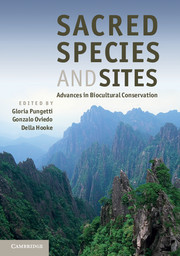Book contents
- Frontmatter
- Contents
- List of Contributors
- Foreword
- Preface
- Acknowledgements
- Introduction
- Part I Concepts and Knowledge
- Part II Sacred Landscapes
- Part III Sacred Sites and People
- Part IV Sacred Species
- Part V Sacred Animals
- Part VI Sacred Groves and Plants
- 21 The sacred tree in the belief and mythology of England
- 22 Sacred groves and biodiversity conservation: a case study from the Western Ghats, India
- 23 Cultural and conservation values of sacred forests in Ghana
- 24 Sacred species of Kenyan sacred sites
- Part VII Implementation and Conclusions
- Index
- Plate Section
- References
24 - Sacred species of Kenyan sacred sites
from Part VI - Sacred Groves and Plants
Published online by Cambridge University Press: 05 August 2012
- Frontmatter
- Contents
- List of Contributors
- Foreword
- Preface
- Acknowledgements
- Introduction
- Part I Concepts and Knowledge
- Part II Sacred Landscapes
- Part III Sacred Sites and People
- Part IV Sacred Species
- Part V Sacred Animals
- Part VI Sacred Groves and Plants
- 21 The sacred tree in the belief and mythology of England
- 22 Sacred groves and biodiversity conservation: a case study from the Western Ghats, India
- 23 Cultural and conservation values of sacred forests in Ghana
- 24 Sacred species of Kenyan sacred sites
- Part VII Implementation and Conclusions
- Index
- Plate Section
- References
Summary
Introduction
Sacred sites are an important component of local people's culture and history, serving as places for appeasing the spirits in the event of calamities, sacrificing for rain, peace-making and conducting certain traditional rites. In this chapter, the term sacred sites is used to refer to specific areas believed by the local people to be traditionally ‘holy’ and associated with supernatural powers; these are highly respected. These sites come in different forms, including sacred lakes, rivers, mountains, hills, caves, forests, single trees and open grounds. Sacred sites are often places that display some unnatural characteristics or appearance. They often have exaggerated features such as size (e.g. too large, too dense, unreachable or display unique formation) and are often respected by the local community.
This chapter provides a broad overview of sacred species of Kenyan sacred sites with emphasis on cultural significance, the biodiversity they support, their current conservation status and the sacred species related to them. The chapter is based on research work undertaken by the author since 1997 to the present time on sacred landscapes of Kenya (including personal communication with village elders between 1997 and 2004). The results show that most of these sites are extremely threatened and on the verge of extinction. There is a clear indication that the threats to the sites are mostly anthropogenic and include agricultural expansion and the clearance of vegetation for setting up homesteads or through the extraction of forest products. Furthermore, there has been a growing knowledge gap between generations, declining use and interest in conserving them as sacred spaces, weakening respect for them, and the gradual conversion of the usually communal land into other uses and private property. The conflict of modern religious faiths and educational ideals with traditional beliefs has had a negative impact on the sites. Several species of plants and animals found within the sites and surrounding areas are considered special and are treated differently based on their socio-cultural value. Using some of the species for construction, as firewood, or killing them is considered a taboo, which has in turn provided such species protection.
- Type
- Chapter
- Information
- Sacred Species and SitesAdvances in Biocultural Conservation, pp. 351 - 364Publisher: Cambridge University PressPrint publication year: 2012



